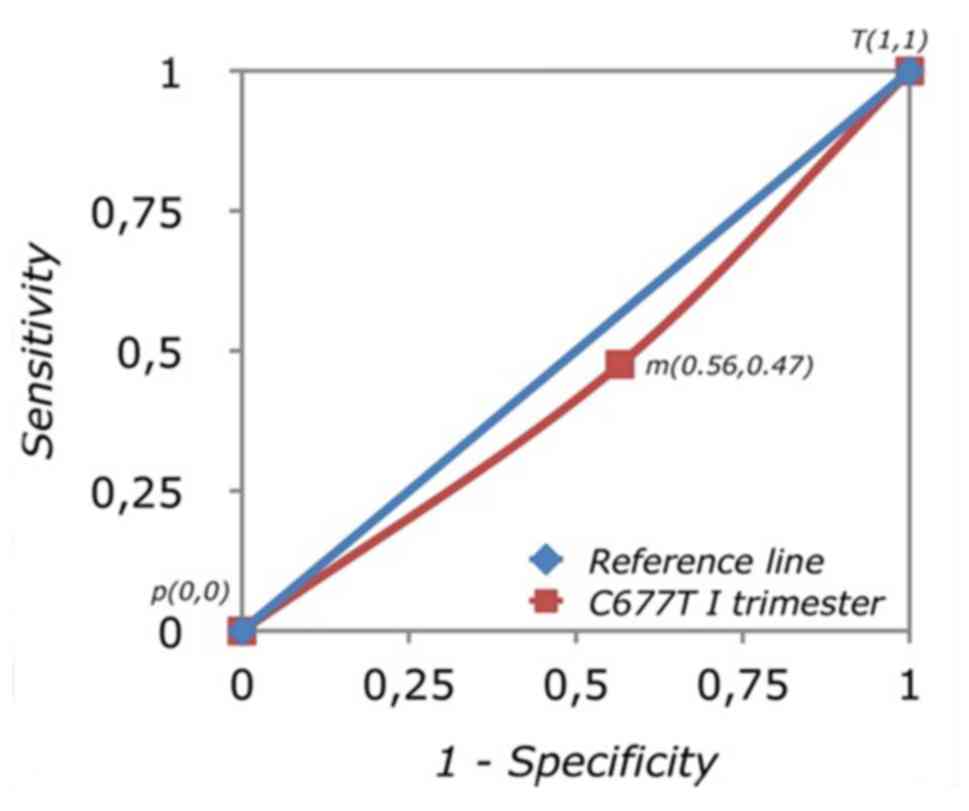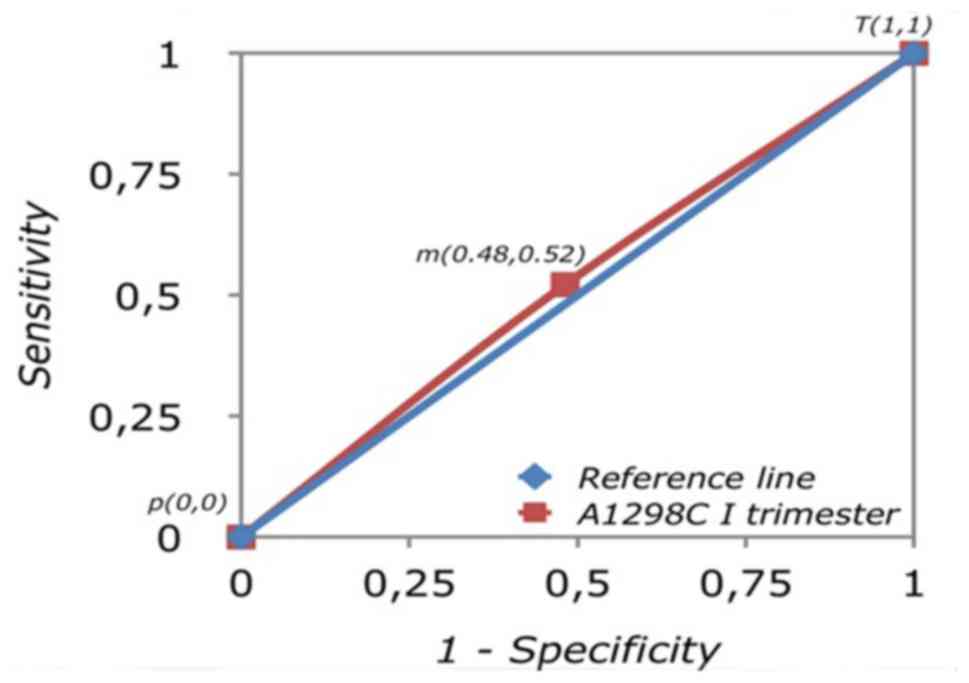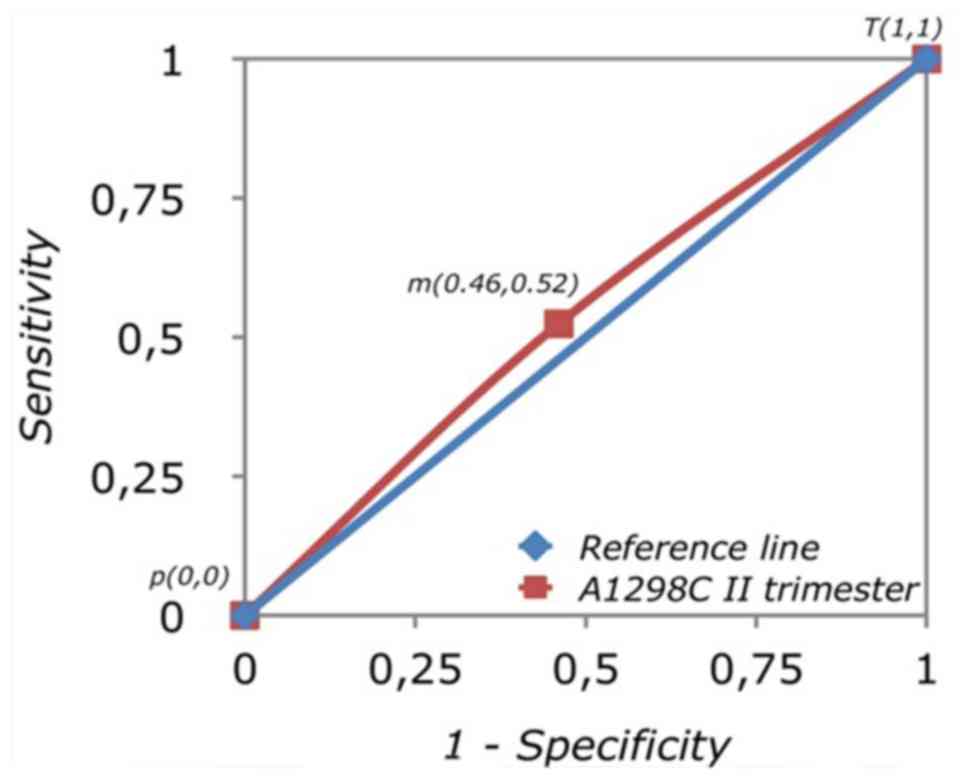Methylenetetrahydrofolate reductase gene C677T and A1298C polymorphisms and susceptibility to recurrent pregnancy loss
- Authors:
- Published online on: January 5, 2018 https://doi.org/10.3892/br.2018.1039
- Pages: 172-175
Abstract
Introduction
In the last five years, several studies have evaluated whether a correlation between the C677T and A1298C polymorphisms of the methylenetetrahydrofolate reductase (MTHFR) gene and a higher risk of recurrent pregnant loss (RPL) exists (1,2). The C677T and A1298C variants of the MTHFR gene, in certain conditions, may lead to an increase in plasma homocysteine (Hcy) and homocysteineemia, which can cause endothelial damage in blood vessels (3). This may increase thromboembolic risk, which in pregnant women can lead to an obstruction of the placental vessels resulting in recurrent abortions. Thus, hyperhomocysteinemia is considered a risk factor for recurrent pregnancy loss (RPL), and patients with RPL may exhibit hyperhomocysteinemia; therefore, as part of routine check-up for RPL, serum homocysteine should be measured. Once diagnosed, treatment of hyperhomocysteinemia with folic acid and vitamin B12 is able to markedly decrease homocysteine levels (3).
Homocysteine (Hcy) is a non-essential, sulfur-containing, non-proteinogenic amino acid. It is an intermediate metabolite in the synthesis of methionine (remethylation reaction) and in the synthesis of cysteine (transulfuration reaction) (3). The enzymes involved in these metabolic pathways are: i) MTHFR, the coenzyme for which is vitamin B9, also known as folic acid (FA)/folate or pteroyl-L-glutamate; ii) methionine synthetase (MS), which uses vitamin B12 (cobalamin) as a cofactor; and iii) cystathionin-β-synthetase (CBS), with vitamin B6 as its coenzyme (3).
The active form of FA in an organism is derived from a reduction reaction of FA into tethrahydrofolic acid (tethrahydrofolate, THF), with the latter being the true coenzyme of MTHFR. MTHFR and MS are involved in the recycling of Hcy into methionine (remethylation reactions), whereby Hcy acquires a methyl group from 5-MTHF to form the methionine (3). A mild or moderate form of hyperhomocysteinemia can be caused by folate deficiency, a direct or indirect lack of 5-methilentethrahydrofolate, a functional defect in MTHFR, MS, CBS or B9, or deficiencies in B12 and B6 vitamins (3).
MTHFR catalyzes irreversible conversion of 5,10-methylentethrahydrofolate to 5-methiltethrahydrofolate (CH3-THF). The normal activity of MTHFR aids to maintain folate and methionine in the bloodstream at constant levels, preventing Hcy accumulation (3). Polymorphisms in the gene encoding MTHFR may lower its enzymatic activity. The variant C677T leads to a substitution of a cytosine into a thymine at position 677 within exon 4 of the MTHFR gene. This genetic variant leads to an amino acidic substitution in position 222 at the protein level (p.Ala>Val) (3). Individuals carrying the MTHFRA222V variant in heterozygous form (genotype Ala/Val) can exhibit a 35% reduction in enzymatic activity relative to the basal activity level of non-carriers, while homozygotes for the variant (genotype Val/Val) can exhibit a 30% reduction in enzymatic activity relative to non-carriers (4). An additional MTHFR polymorphism associated with a reduction in enzyme activity is the substitution of an adenine with a cytosine in position 1,298 (A1298C) (5,6). This variation leads to the substitution of a glutamate with an alanine in position 429 at the protein level (p.429Glu>Ala) (7). It has been demonstrated that the C677T and A1298C polymorphisms in heterozygous form, along with a folate deficiency, lead to increased levels of plasmatic Hcy (7).
Patients carrying the C677T polymorphism of MTHFR in homozygous form (TT), leading to a thermolabile MTHFR variant, exhibit decreased formation of CH3-THF under conditions of folate deficiency: This leads to lower production of S-adenosylmethionine and subsequently lower availability of methyl groups (-CH3) required for methylation events, including the methylation of DNA (8,9). Additionally, the lower availability of CH3-THF results in reduced remethylation of Hcy, followed by an increase in plasmatic Hcy (hyperhomocysteinemia) (8). Conversely, wild-type individuals for the C677T genotype (CC) are not influenced by folate deficiency, and thus CH3-THF synthesis for the methylation reaction and for the conversion of Hcy in methionine is preserved. Regarding these processes, the C677T and A1298C genotypes should not affect the availability of CH3-THF under an adequate supply of folate (9). However, current methods are unable to delineate a direct correlation between the aforementioned variants of the MTHFR gene and thromboembolic risk, and in turn, risk of RPL in pregnant women. The aim of the present study was to investigate the putative association between the C677T and A1298C variants and RPL risk.
Subjects and methods
Subjects
A total of 767 pregnant women (mean age, 30±1.2 years) who visited the Unit of Cytogenetic and Molecular Genetics, ‘Madonna delle Grazie’ Hospital (Matera, Italy) from January 2010 to July 2016 to undergo molecular tests for the detection of the C677T and A1298C variants of the MTHFR gene were enrolled. The pregnant women were divided into two groups (group A and group B) based on miscarriage history. The present study protocol was approved by the Ethics Committee of Basilicata University (Potenza, Italy) and all participants provided written informed consent.
Pregnant women belonging to group A (n=380) had positive anamnesis of at least two miscarriage events. These women exhibited negative responses to antithrombin deficiency, anticoagulant C protein and protein S tests, exhibited no increased resistance to activated C protein, had neither the A20210G mutation in prothrombin gene nor the G1691A mutation in Leiden factor V gene (p.Arg506Gln). They also had a negative response to antiphospholipid antibodies. The pregnant women belonging to group B (n=387) were experiencing their second or third pregnancy and had negative anamnesis for miscarriage, as well as negative results in the aforementioned clinical tests. All enrolled patients and their partners carried a normal karyotype.
Groups A and B were further divided into two subgroups based on gestational age [first trimester (≤13 weeks of gestation) and second trimester (from 17 weeks and 4 days to 26 weeks and 2 days of gestation)]. Thus, the 380 women in group A were partitioned as those who had a miscarriage during the first trimester of pregnancy (343/380) and those who had a miscarriage in the second trimester of pregnancy (37/380). The 387 women in group B (control group) were partitioned as those subjected to molecular testing in the first trimester of pregnancy (244/387) and those subjected to molecular testing in the second trimester of pregnancy (143/387).
Groups A and B were subjected to preconception prophylaxis (at least one month prior to conception) with oral administration of 400 mcg (6S)-5-methyltetrahydrofolic acid glucosamine salt, 1.75 g myo-inositol, 250 mg D-chiro-inositolo, 120 mg vitamin C; 100 mg methylsulfonylmethane and 12.5 mg zinc (Logus Pharma Srl, San Marino, Italy; cat. no. SM22015 47849).
DNA extraction and molecular analysis
For all subjects, molecular testing was performed on venous blood samples (in EDTA-K3) according to the following steps: i) DNA was isolated from 25 µl venous blood using a DNA extraction kit obtained from Nuclear Laser Medicine Srl (Settala, Italy; cat. no. AA1001); ii) to study the C677T and A1298C variants of the MTHFR gene, the target genomic area was amplified by polymerase chain reaction (PCR) using two commercial kits provided by Nuclear Laser Medicine Srl [cat. nos. AA901 (C677T) and AA902 (A1298C)]. Following kit protocols, this enabled the detection of single nucleotide polymorphisms using a Rotor-Gene Q MDx (Qiagen Srl, Milan, Italy) using fluorescent oligos annealed to specific DNA target sequences in the gene of interest, and the PCR products were quantified using the Fluorescent Resonance Energy Transfer method (10); iii) the variants of the target sequences were measured from melting curves.
Statistical analysis
The results were compared through receiver operating characteristic (ROC) curve using JMP software version 2 (https://www.jmp.com/it_it/home.html). The ROC curve permits assessment of the accuracy of a diagnostic test. Analysis of a ROC curve is based on the evaluation of the area under the curve (AUC): This expresses the probability that the parameter of an individual randomly selected from the test population is higher than the parameter of an individual randomly selected from the control sample. In reality, it considers appropriate tests with an AUC ≥80%. The statistical indicators used to define this graph are specificity (Sp) and sensitivity (Se). The Sp of a diagnostic test indicates the ability of the test to correctly separate, in the studied population, healthy individuals from individuals carrying the medical condition of interest (11).
Results and Discussion
MTHFR polymorphism genotypes
Of the 380 pregnant women in group A, 86 heterozygotes and 74 homozygotes for C677T were identified, while 54 heterozygotes and 32 homozygotes for A1298C were identified. A total of 103 were compound heterozygotes, and31 were devoid of mutation.
Of the 387 pregnant women in group B, 100 heterozygotes and 90 homozygotes for C677T were identified. For the A1298C variant, 35 were heterozygous and 32 were homozygous. A total of 110 subjects were compound heterozygotes and 20 lacked mutation.
Comparison of polymorphism genotypes in the first and second trimesters of pregnancy
C677T and A1298C genotype data were compared between the women in groups A and B in their first trimester of pregnancy. Additionally, C677T and A1289C genotype data were compared between the women in groups A and B in their second trimester of pregnancy. The results were compared through ROC curve and Z-score statistics.
On ROC curve analysis of all pregnant women in their first trimester of pregnancy based on the presence of C677T in MTHFR, an AUC of 0.45 area units (au) with 95% confidence interval (CI) 0.30–0.56 was derived (Fig. 1). From a statistical point of view, the area under the reference line is equal to 0.5 au: This value is associated with a diagnostic test without discriminatory qualities, and thus is null. From this data, it may be inferred that there was no association between MTHFR C677T and RPL; therefore, the C677T variant in the considered sample was not useful regarding diagnostic value. The probability of identifying an individual carrying the C677T mutation in the analyzed population was random. These findings were confirmed by the same analysis (C677T vs. WT) performed in the pregnant women in their second trimester of pregnancy. The AUC was 0.46 au with 95% CI 0.37–0.67 (Fig. 2).
Analysis of the A1298C variant in MTHFR was subsequently performed. The molecular screening of all women in their first trimester obtained an AUC of 0.51 au (95% CI: 0.40–0.67; Fig. 3). In this case, the results indicated that this screening test was not useful. The negative diagnostic application of this molecular screening of A1298C was confirmed by the same analysis in the women in their second trimester: The AUC was 0.52 au (95% CI: 0.44–0.67; Fig. 4), indicating the random effect that an individual carrying this mutation belonged to the study population rather than the control. This indicated that there was no association between the A1298C variant and RLP risk.
In conclusion, based on the present findings, to carry the C677T and A1298C variants of the MTHFR gene does not appear to influence predisposition to miscarriage in the first or second trimester of pregnancy. Thus, it may be unadvantageous to analyze them for diagnostic aims. However, daily intake of folic acid remains an important therapeutic practice for pregnant women in order to reduce the risk of congenital defects among other complications (12–14). Regarding MTHFR and RPL risk, interaction with other genetic variants has also been speculated (15) and requires investigation.
Acknowledgements
The authors are thankful to the ‘Association Gian Franco Lupo’ (ONLUS: a non-profit organization of social utility) for their support.
References
|
Yang Y, Luo Y, Yuan J, Tang Y, Xiong L, Xu M, Rao X and Liu H: Association between maternal, fetal and paternal MTHFR gene C677T and A1298C polymorphisms and risk of recurrent pregnancy loss: A comprehensive evaluation. Arch Gynecol Obstet. 293:1197–1211. 2016. View Article : Google Scholar : PubMed/NCBI | |
|
Levin BL and Varga E: MTHFR: Addressing Genetic Counseling Dilemmas Using Evidence-Based Literature. J Genet Couns. 25:901–911. 2016. View Article : Google Scholar : PubMed/NCBI | |
|
Park WC and Chang JH: Clinical Implications of Methylenetetrahydrofolate Reductase Mutations and Plasma Homocysteine Levels in Patients with Thromboembolic Occlusion. Vasc Spec Int. 30:113–119. 2014. View Article : Google Scholar | |
|
Baum L, Wong KS, Ng HK, Tomlinson B, Rainer TH, Chan DK, Thomas GN, Chen X, Poon P, Cheung WS, et al: Methylenetetrahydrofolate reductase gene A222V polymorphism and risk of ischemic stroke. Clin Chem Lab Med. 42:1370–1376. 2004. View Article : Google Scholar : PubMed/NCBI | |
|
Sibani S, Leclerc D, Weisberg IS, O'Ferrall E, Watkins D, Artigas C, Rosenblatt DS and Rozen R: Characterization of mutations in severe methylenetetrahydrofolate reductase deficiency reveals an FAD-responsive mutation. Hum Mutat. 21:509–520. 2003. View Article : Google Scholar : PubMed/NCBI | |
|
Botto N, Andreassi MG, Manfredi S, Masetti S, Cocci F, Colombo MG, Storti S, Rizza A and Biagini A: Genetic polymorphisms in folate and homocysteine metabolism as risk factors for DNA damage. Eur J Hum Genet. 11:671–678. 2003. View Article : Google Scholar : PubMed/NCBI | |
|
Friso S and Choi SW: Gene-nutrient interactions and DNA methylation. J Nutr. 132:2382S–2387S. 2002.PubMed/NCBI | |
|
Dell'edera D, Tinelli A, Milazzo GN, Malvasi A, Domenico C, Pacella E, Pierluigi C, Giuseppe T, Marcello G, Francesco L, et al: Effect of multivitamins on plasma homocysteine in patients with the 5,10 methylenetetrahydrofolate reductase C677T homozygous state. Mol Med Rep. 8:609–612. 2013. View Article : Google Scholar : PubMed/NCBI | |
|
Martinez-Serra J, Robles J, Nicolàs A, Gutierrez A, Ros T, Amat JC, Alemany R, Vögler O, Abelló A, Noguera A, et al: Fluorescence resonance energy transfer-based real-time polymerase chain reaction method without DNA extraction for the genotyping of F5, F2, F12, MTHFR, and HFE. J Blood Med. 5:99–106. 2014. View Article : Google Scholar : PubMed/NCBI | |
|
Pritchett YL and Tamura R: Global benefit-risk assessment in designing clinical trials and some statistical considerations of the method. Pharm Stat. 7:170–178. 2008. View Article : Google Scholar : PubMed/NCBI | |
|
Schmidt RJ, Tancredi DJ, Ozonoff S, Hansen RL, Hartiala J, Allayee H, Schmidt LC, Tassone F and Hertz-Picciotto I: Maternal periconceptional folic acid intake and risk of autism spectrum disorders and developmental delay in the CHARGE (CHildhood Autism Risks from Genetics and Environment) case-control study. Am J Clin Nutr. 96:80–89. 2012. View Article : Google Scholar : PubMed/NCBI | |
|
Parker SE, Yazdy MM, Tinker SC, Mitchell AA and Werler MM: The impact of folic acid intake on the association among diabetes mellitus, obesity, and spina bifida. Am J Obstet Gynecol. 209:239.e1–239.e8. 2013. View Article : Google Scholar | |
|
Friberg AK and Jørgensen FS: Periconceptional folic acid prophylaxis and neural tube defects. Ugeskr Laeger. 177:1595–1598. 2015.(In Danish). PubMed/NCBI | |
|
Greene ND, Leung KY, Gay V, Burren K, Mills K, Chitty LS and Copp AJ: Inositol for prevention of neural tube defects: A pilot randomised controlled trial - CORRIGENDUM. Br J Nutr. 115:16972016. View Article : Google Scholar : PubMed/NCBI | |
|
Settin A, Elshazli R, Salama A and ElBaz R: Methylenetetrahydrofolate reductase gene polymorphisms in Egyptian women with unexplained recurrent pregnancy loss. Genet Test Mol Biomarkers. 15:887–892. 2011. View Article : Google Scholar : PubMed/NCBI |













